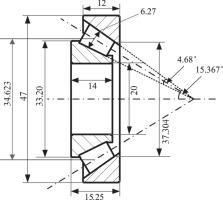当前位置:
X-MOL 学术
›
Mech. Mach. Theory
›
论文详情
Our official English website, www.x-mol.net, welcomes your feedback! (Note: you will need to create a separate account there.)
Robust optimum design of tapered roller bearings based on maximization of fatigue life using evolutionary algorithm
Mechanism and Machine Theory ( IF 5.2 ) Pub Date : 2020-10-01 , DOI: 10.1016/j.mechmachtheory.2020.103894 Shashikant Kumar Verma , Rajiv Tiwari
Mechanism and Machine Theory ( IF 5.2 ) Pub Date : 2020-10-01 , DOI: 10.1016/j.mechmachtheory.2020.103894 Shashikant Kumar Verma , Rajiv Tiwari

|
Abstract For satisfactory performance of rolling element bearings, they must be designed for long fatigue life. As the fatigue life of the bearings is directly affected by its dynamic capacity, therefore the latter has been chosen as an objective function, which is to be optimized using a robust design optimization. Robust design improves the quality of a product by optimising its mean performance and minimising variation in its performance that incurred due to uncertainties present with the product. Also at the same time, it maintains the design feasibility under realistic and probabilistic constraints. The uncertainties considered in this bearing design problem is the tolerance in bearing dimensions since bearings cannot be manufactured with the exact dimension. In this work, tapered roller bearings has been designed in such a way that it will have maximum dynamic capacity but along with it, it will have minimum variation in its dynamic capacity due to variation in basic dimensions. Therefore, objective of the problem is not to only maximize the dynamic capacity but also to minimise its variation to an extent level. A nonlinear constrained optimization problem has been formulated with single objective function, thirty realistic constraints and eleven design variables. Constraints are basically based on geometrical parameters and strength criterion. Out of total eleven design variables, five are geometrical parameters that directly affect the dynamic capacity and six are constraints parameters, which present in the constraints and affects the possible feasible design space. Real coded genetic algorithm has been used as an optimization tool and the result obtained are compared with the standard bearings in catalogue and that are indicating a drastic improvement in the bearing life. Their life is found to be on an average 1.5 times of the life of standard bearings in catalogues. A constraints violation study has been carried out to prioritise the constraints for faster convergence. A convergence study and sensitivity analysis have also been carried out. Convergence study ensured the global optima in the feasible design space. To perform sensitivity analysis, the variation of dynamic capacity with respect to all basic design variables, i.e. bearing pitch diameter, roller mean diameter, roller effective length and the nominal contact angle have been calculated. These are found to be a positive value indicating that dynamic capacity has a positive variation with respect to them. The same has been calculated for bearing 30,204 considering positive tolerance, the least variation is found 0.00018 times dynamic capacity, which is with respect to the bearing pitch diameter. Whereas, the most variation is 0.212 times dynamic capacity, which is with respect to the nominal contact angle. This shows that the bearing dynamic capacity is highly sensitive to the variation in nominal contact angle and least sensitive to the variation in bearing pitch diameter. Therefore, while manufacturing, the manufacturer should have more attention on contact angle. Finally, for visualisation, radial dimensions of optimized bearing 30,204 with positive tolerance have been drawn, showing no interference among the dimensions, which indicates a geometrically feasible design. Hence, the present paper allows a designer to design rolling bearings with maximum fatigue life and minimum variation in its performance due to tolerance accounted during manufacturing. The present problem is not limited to the bearings only, but can also be applied in optimization of any machine components (e.g. gears, cams, springs, etc.) having significant uncertainties in their materials or geometrical parameters such as modulus, thickness, residual strain, density, etc.
中文翻译:

基于进化算法最大化疲劳寿命的圆锥滚子轴承稳健优化设计
摘要 为了使滚动轴承具有令人满意的性能,必须设计成具有较长的疲劳寿命。由于轴承的疲劳寿命直接受其动态容量的影响,因此选择后者作为目标函数,使用稳健的设计优化对其进行优化。稳健设计通过优化产品的平均性能并最大限度地减少由于产品存在的不确定性而导致的性能变化,从而提高了产品的质量。同时,它在现实和概率约束下保持设计可行性。在这个轴承设计问题中考虑的不确定性是轴承尺寸的公差,因为轴承不能以精确的尺寸制造。在这项工作中,圆锥滚子轴承的设计使其具有最大的动态容量,但与此同时,由于基本尺寸的变化,其动态容量的变化将最小。因此,该问题的目标不仅是最大化动态容量,而且是在一定程度上最小化其变化。非线性约束优化问题已经用单一目标函数、三十个现实约束和十一个设计变量来制定。约束基本上基于几何参数和强度准则。在总共十一个设计变量中,五个是直接影响动态容量的几何参数,六个是约束参数,它们存在于约束中并影响可能的可行设计空间。实编码遗传算法已被用作优化工具,所得结果与目录中的标准轴承进行了比较,表明轴承寿命得到了显着提高。发现它们的寿命平均是目录中标准轴承寿命的 1.5 倍。已经进行了约束违规研究,以优先考虑约束以加快收敛。还进行了收敛性研究和敏感性分析。收敛性研究保证了可行设计空间中的全局最优。为了进行敏感性分析,计算了所有基本设计变量的动态容量变化,即轴承节圆直径、滚子平均直径、滚子有效长度和公称接触角。发现这些是正值,表明动态容量相对于它们具有正变化。考虑到正公差,对轴承 30,204 进行了相同的计算,发现最小变化是动态容量的 0.00018 倍,这与轴承中径有关。而最大的变化是动态容量的 0.212 倍,这是相对于标称接触角而言的。这表明轴承动态容量对公称接触角的变化高度敏感,对轴承节圆直径的变化最不敏感。因此,制造商在制造时更应注意接触角。最后,为了可视化,绘制了具有正公差的优化轴承 30,204 的径向尺寸,显示尺寸之间没有干扰,这表明几何上可行的设计。因此,本文允许设计者设计具有最大疲劳寿命和最小由于制造过程中考虑的公差而导致的性能变化的滚动轴承。目前的问题不仅限于轴承,还可以应用于任何机器部件(例如齿轮、凸轮、弹簧等)的优化,这些部件的材料或几何参数(例如模量、厚度、残余应变)具有很大的不确定性、密度等。
更新日期:2020-10-01
中文翻译:

基于进化算法最大化疲劳寿命的圆锥滚子轴承稳健优化设计
摘要 为了使滚动轴承具有令人满意的性能,必须设计成具有较长的疲劳寿命。由于轴承的疲劳寿命直接受其动态容量的影响,因此选择后者作为目标函数,使用稳健的设计优化对其进行优化。稳健设计通过优化产品的平均性能并最大限度地减少由于产品存在的不确定性而导致的性能变化,从而提高了产品的质量。同时,它在现实和概率约束下保持设计可行性。在这个轴承设计问题中考虑的不确定性是轴承尺寸的公差,因为轴承不能以精确的尺寸制造。在这项工作中,圆锥滚子轴承的设计使其具有最大的动态容量,但与此同时,由于基本尺寸的变化,其动态容量的变化将最小。因此,该问题的目标不仅是最大化动态容量,而且是在一定程度上最小化其变化。非线性约束优化问题已经用单一目标函数、三十个现实约束和十一个设计变量来制定。约束基本上基于几何参数和强度准则。在总共十一个设计变量中,五个是直接影响动态容量的几何参数,六个是约束参数,它们存在于约束中并影响可能的可行设计空间。实编码遗传算法已被用作优化工具,所得结果与目录中的标准轴承进行了比较,表明轴承寿命得到了显着提高。发现它们的寿命平均是目录中标准轴承寿命的 1.5 倍。已经进行了约束违规研究,以优先考虑约束以加快收敛。还进行了收敛性研究和敏感性分析。收敛性研究保证了可行设计空间中的全局最优。为了进行敏感性分析,计算了所有基本设计变量的动态容量变化,即轴承节圆直径、滚子平均直径、滚子有效长度和公称接触角。发现这些是正值,表明动态容量相对于它们具有正变化。考虑到正公差,对轴承 30,204 进行了相同的计算,发现最小变化是动态容量的 0.00018 倍,这与轴承中径有关。而最大的变化是动态容量的 0.212 倍,这是相对于标称接触角而言的。这表明轴承动态容量对公称接触角的变化高度敏感,对轴承节圆直径的变化最不敏感。因此,制造商在制造时更应注意接触角。最后,为了可视化,绘制了具有正公差的优化轴承 30,204 的径向尺寸,显示尺寸之间没有干扰,这表明几何上可行的设计。因此,本文允许设计者设计具有最大疲劳寿命和最小由于制造过程中考虑的公差而导致的性能变化的滚动轴承。目前的问题不仅限于轴承,还可以应用于任何机器部件(例如齿轮、凸轮、弹簧等)的优化,这些部件的材料或几何参数(例如模量、厚度、残余应变)具有很大的不确定性、密度等。


























 京公网安备 11010802027423号
京公网安备 11010802027423号